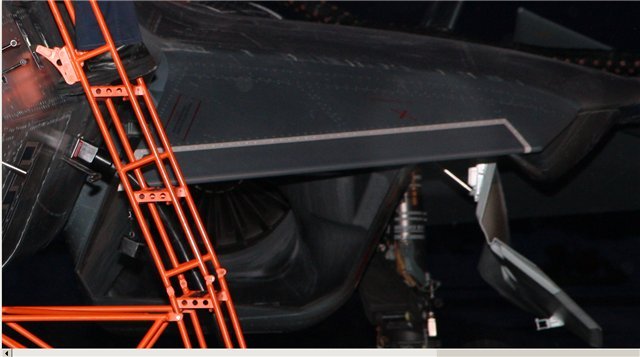Will the gap between 2 engines or intakes increase some RCS?
It's possible but here is my take, from the side the intakes are no different than other 'stealth' aircraft, that is the intakes are sloped and curved. But once EM energy hits the underside of the fuselage the wave pattern becomes complex and difficult to predict (for us at least), we know that the intakes are a spherical curved body, and we know EM energy travels around curved surfaces, something called 'creeping wave' from this we know that the majority of the energy will scatter away from the aircraft. However, some will likely come in contact with the weapons bays that are housed between the intakes, when this occurs the waves energy should simply be diffracted away from the source of EM energy. Simply put I do not see how the fuselage would cause any significant spike in RCS.
The current Pak-fa prototype has a much larger RCS than J-20. If you take a close look the Pak-fa you will see that its engines are completely exposed to radar, you can even see it. You can not see that in F-22, J-20 and JSF.
The pak-fa prototype is not meant for low observability tests, it's only an aerodynamics test bed; in total there will be between 6-10 prototypes build, the T-50-1 model is simply built to record aerodynamic information. The designers never had a need to install radar blockers, or even cover the rivets, even if they did it would make no sense since the aircraft is full of antennas meant for recording information.
I hope that Pak-fa's designer will change that, they HAVE to add DSI inlet to hide its engine compressor fan blade or its stealth will be nothing compareing to J-20. Because it is not possible to make stealthy engine fan blade, the compressor fan blade are spining at 5000 RPM making it impossible to be made stealth. You have to deplove DSI inlet other other inlet design to hide it.
There are a number of ways to shield the intake compressors, the most talked about is radar blocker, the F-117 had radar blockers and many other aircraft have or had them, other methods involve curved inlets, ect. The important thing is the designers know about this and will not just leave the intake compressors exposed. Even more interesting is that Sukhoi is currently studying flat nozzles, this just shows that the final version will likely be much different than the aerodynamics test bed we see flying.
In any case your argument about radar blockers is plainly wrong considering the F-15 SE has the same frontal RCS as the F-35 and even the F-117 used radar blockers. If i was you i would wory more about the J-20's canards instead telling everyone about how poor the pak-fa is, if you want to know why they are a problem visit the J-20 thread thread for a real explanation, since you think canards do nothing for stealth.









